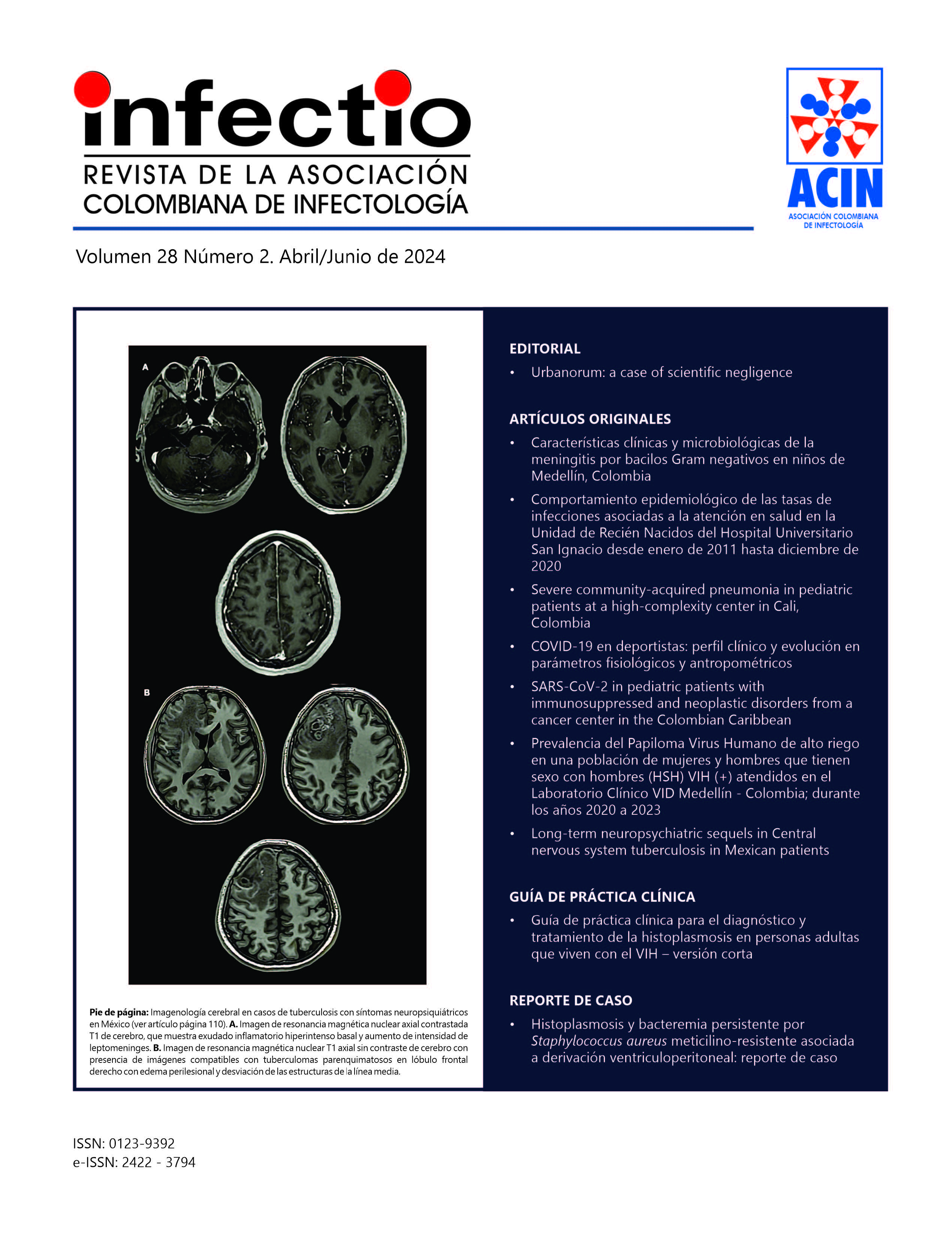Prevalencia del papiloma virus humano de alto riego en una población de mujeres y hombres que tienen sexo con hombres (HSH) VIH (+) atendidos en el Laboratorio Clínico VID Medellín - Colombia; durante los años 2020 a 2023
Contenido principal del artículo
Resumen
Objetivo: identificar la prevalencia de los VPH de alto riesgo en mujeres y en hombres que tienen sexo con hombres VIH positivos, durante el periodo comprendido entre 2020 y 2023. Materiales y método: Estudio observacional descriptivo retrospectivo, de pacientes que acudieron al Laboratorio Clínico VID. Se incluyeron todos los pacientes que llegaron con el propósito de realizarse la prueba de VPH y que cumplían con los criterios para la toma de la muestra. Resultados: el total de pacientes incluidos en el estudio fue de 2.379 mujeres y 2.078 HSH-VIH (+).Se identifica VPH-AR en 586 mujeres y 1.652 HSH-VIH (+).La frecuencia de genotipos de alto riesgo identificados fue de 0,36 % en las mujeres y de 2,52 % en los HSH VIH (+). Los genotipos de VPH más prevalentes en ambos grupos fueron: 16, 52, 58 y 68. Conclusiones: La prevalencia de VPH-AR en las mujeres fue de 26,4 % y en los hombres que tienen sexo con hombres de 79,5 %, la mayoría de los genotipos de alto riesgo presentes en mujeres se encuentran en el rango de edad entre los 30-39 años, mientras que en los HSH VIH (+) se encuentran en el rango de menor de 30 años.
Detalles del artículo
Citas
Junior J, Salazar M, Rojas Sumaran, VA. Tendencias de la investigación del virus del papiloma humano en Latinoamérica frente a los países de altos ingresos. Rev Colomb Obstet Gineco 2017; 68: 202-217. https://doi.org/10.18597/rcog.2679
De Sanjosé S, Diaz M, Castellsagué X, Clifford G, Bruni L, Muñoz N, et al Worldwide prevalence and genotype distribution of cervical human papillomavirus DNA in women with normal cytology: a meta-analysis. Lancet Infect Dis. 2007 Jul; 7(7):453-9 https://doi.org/10.1016/S1473-3099(07)70158-5
Molano M, van den Brule A, Plummer M, Weiderpass E, Posso H, Arslan A, et al. Determinants of clearance of human papillomavirus infections in Colombian women with normal cytology: a population-based, 5-year follow-up study. Am J Epidemiol. 2003; 158: 486-94 DOI: https://doi.org/10.1093/aje/
Del Río-Ospina L, Soto De León SC, Camargo M, Sánchez R, Mancilla CL, Patarroyo ME, et al. The prevalence of high-risk HPV types and factors determining infection in female colombian adolescents. PLoS ONE. 2016;11:e0166502. https://doi.org/10.1371/journal.pone.0166502
Weinstock H, Berman S, Cates W Jr. Sexually transmitted diseases among American Youth: incidence and prevalence estimaters, 2000. Perspect Sex Reprod Health. Jan-Feb 2004; 356(1); 6-10. https://doi.org/10.1111/j.1931-2393.2004.tb00002.x
Koutsky LA. Epidemiology of genital human papillomavirus infection. Am J Med. 1997; 102 (5): 3-8 doi: https://doi.org/10.1016/S0002-9343(97)00177-0
Centro para el Control y la Prevención de Enfermedades (CDC). Virus del papiloma humano: Información sobre el VPH para los médicos. 2007; 1-26.
Máster Diagnóstica S.L. HPV Direct Flow Chip Kit (HS12) Screening y genotipado del virus del papiloma humano mediante amplificación e hibridación específica 2016/10/03.
Palacio Saucedo G, Vásquez Guillen J, Riviera Morales L, Gracias Cabello R, Sanchez Fresno E, et al. Prevalencia y genotipos del virus del papiloma humano en muestras de tejido laríngeo de pacientes con cáncer de laringe del noreste de México. Cir. 2018; 86: 499-507. DOI: https://doi.org/10.24875/CIRU.18000297
Formana D,Catherine de Martelb C, Laceyc Ch J, Soerjomatarama I, Global Burden of Human Papillomavirus and Related Diseases. journal home pag e: www.elsevier.com/locate/vaccine. Vaccine 30S (2012) F12- F23. doi: https://doi.org/10.1016/j.vaccine.2012.07.055
Plotzker R.E. Vaidya A, Pokharel U, Elizabeth A. Sexually Transmitted Human Papillomavirus Update in Epidemiology, Prevention, and Management. Infect Dis Clin N Am 37 (2023) 289-310 https://doi.org/10.1016/j.idc.2023.02.008
Castellsague X. Natural history and epidemiology of HPV infection and cervical cancer. Gynecol Oncol 2008; 110(3):S4-7. doi: https://doi.org/10.1016/j.ygyno.2008.07.045
Simpson S Jr, Blomfield P, Cornall A, et al. Front-to-back & dabbing wiping behaviour post-toilet associated with anal neoplasia & HR-HPV carriage in women with previous HPV-mediated gynaecological neoplasia. Cancer Epidemiology 2016; 42: 124-32. doi: https://doi.org/10.1016/j.canep.2016.04.001
Morbidity and Mortality Weekly Report Recommendations and Reports / Vol. 70 / No. 4 July 23, 2021 Sexually Transmitted Infections Treatment Guidelines, 2021. DOI: https://doi.org/10.15585/mmwr.rr7004a1
Burd EM. Human papillomavirus and cervical cancer. Clin Microbiol Rev 2003; 16(1):1-17. doi: https://doi.org/10.1128/CMR.16.1.1-17.2003
Machalek DA, Poynten M, Jin F, et al. Anal human papillomavirus infection and associated neoplastic lesions in men who have sex with men: a systematic review and meta-analysis. The lancet oncology 2012; 13(5):487-500. doi: https://doi.org/10.1016/S1470-2045(12)70080-3
Looker KJ, Ronn MM, Brock PM, et al. Evidence of synergistic relationships between HIV and Human Papillomavirus (HPV): systematic reviews and meta-analyses of longitudinal studies of HPV acquisition and clearance by HIV status,and of HIV acquisition by HPV status. J Int AIDS Soc 2018; 21(6):e25110. doi: https://doi.org/10.1002/jia2.25110
Toro Montoya AI, Tapia Vela LJT V. Virus del papiloma humano (VPH) y cáncer. Med. Lab. [Internet]. 5 de abril de 2021; 25(2):467-83. https://doi.org/10.36384/01232576.431
Pérez González, A.; Cachay,E.; Ocampo, A.; Poveda, E. Update on the Epidemiological Features and Clinical Implications of Human Papillomavirus Infection (HPV) and Human Immunodeficiency Viru (HIV) Coinfection. Microorganisms 2022, 10, 1047. https://doi.org/10.3390/microorganisms10051047
Chowdhury, S.; Darragh, T.M.; Berry Lawhorn, J.M.; Isaguliants, M.G.; Vonsky, M.S.; Hilton, J.F.; Lazar, A.A.; Palefsky, J.M. HPV Type Distribution in Benign, High-Grade Squamous Intraepithelial Lesions and Squamous Cell Cancers of the Anus by HIV Status. Cancers 2023, 15, 660. https://doi.org/10.3390/cancers15030660
Machalek DA, Poynten M, Jin F, et al. Anal human papillomavirus infection and associated neoplastic lesions in men who have sex with men: a systematic review and meta-analysis. Lancet Oncol 2012; 13: 487-500. doi: https://doi.org/10.1016/S1470-2045(12)70080-3
D'Souza G, Wiley DJ, Li X, et al. Incidence and epidemiology of anal cancer in the multicenter AIDS cohort study.J Acquir Immune Defi c Syndr 2008; 48: 491-99. doi: https://doi.org/10.1097/QAI.0b013e31817aebfe

